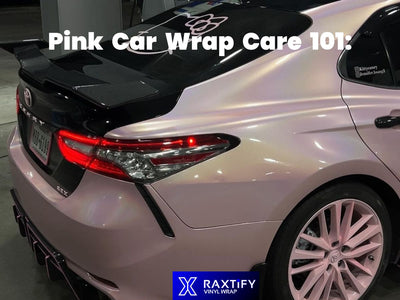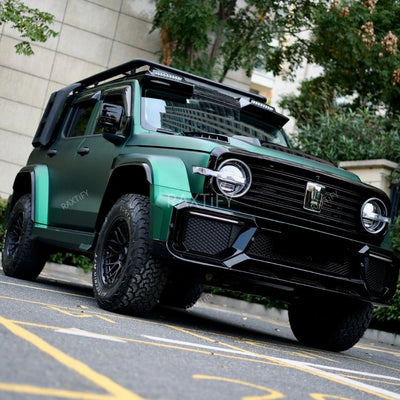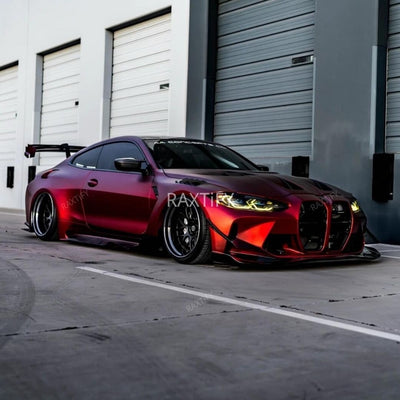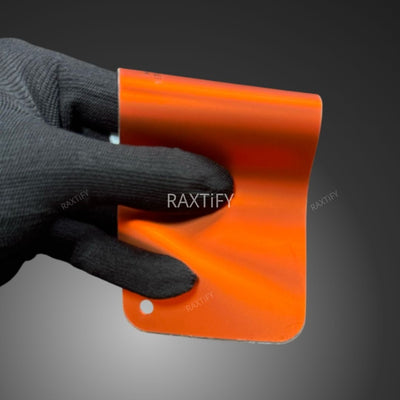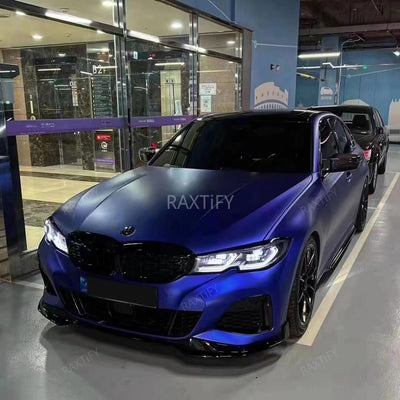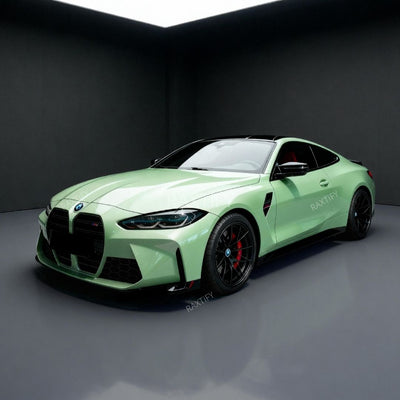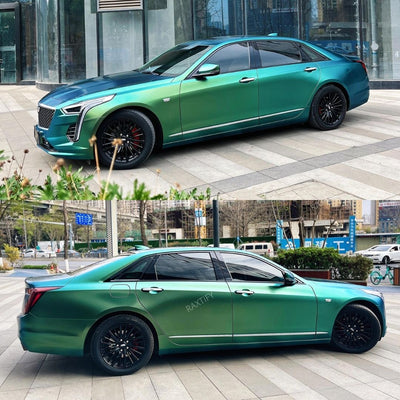
THE FACTS ABOUT PAINT PROTECTION FILM
Paint protection film (PPF) is a game-changer in modern vehicle care. Crafted from a thin yet robust polymer or polyurethane, it serves as the ultimate shield for your ride's clear coat. With its exceptional durability, PPF defends against a barrage of threats: from chemical exposure and UV rays to corrosive acid rain and the barrage of debris encountered on the road. But here's the kicker – it doesn't just protect; it saves you big bucks. In the event of paint damage from road debris, PPF can spare you the agony of costly auto body repairs.
Amidst the sea of information about PPF on the internet, distinguishing fact from fiction can be tricky. Enter ceramic coating – another subject fraught with misinformation. So, let's set the record straight about paint protection film.
What is Paint Protection Film?
Paint protection film, or PPF, has a rich history rooted in solving real-world problems. Its origins trace back to the Vietnam War when the US Department of Defense sought to safeguard helicopter rotor blades from damage caused by shrapnel and debris. 3M rose to the challenge, developing what became known as helicopter tape – a specialized urethane film prioritizing function over aesthetics.
Fast forward to today, and PPF has evolved into a versatile solution, surpassing its humble beginnings. No longer just a utilitarian defense, modern PPF, like RAXTiFY's offerings, boasts thermoplastic urethane construction available in various grades, thicknesses, and customizable finishes. From enhancing gloss to achieving a matte look, the possibilities are endless.
When it comes to purchasing PPF, RAXTiFY stands out as a top choice. Renowned for utilizing the highest quality materials and boasting a loyal customer base, RAXTiFY's PPF guarantees exceptional performance and durability. Whether safeguarding your vehicle's paint or enhancing its aesthetic appeal, RAXTiFY's PPF sets the standard for excellence.

Why choose RAXTiFY PPF? Here are just a few reasons:
-
Ultimate Protection: Shield your vehicle from acidic corrosion, contaminants like bug guts and bird droppings, and the damaging effects of acid rain and mineral deposits.
-
Defends Against Damage: Say goodbye to unsightly water spots and oxidation caused by UV light. RAXTiFY PPF acts as a barrier against small rocks, gravel, tree branches, and other hard objects that can mar your paint surface.
-
Self-Healing Technology: Worried about scratches or minor impacts? RAXTiFY PPF has you covered with its self-healing properties. Watch as minor scratches vanish before your eyes, keeping your vehicle looking pristine.
-
Long-Lasting Performance: With RAXTiFY PPF, durability is a guarantee. Enjoy peace of mind knowing your investment is protected for up to 8+ years.
What are the Types of Paint Protection Film?
Paint protection film (PPF) stands out as one of the best solutions for preserving the appearance of cars, with 3M Corporation being a pioneer in this field. Originally developed to safeguard helicopter rotor blades, PPF has evolved into a diverse market offering various brands and designs tailored to car enthusiasts.
Despite common misconceptions associating brands with specific material properties, the brand of PPF does not always reflect its quality or features. Leading brands like 3M Paint Protection Film Pro Series, Llumar, Suntek, and Xpel offer different options, from full wraps to partial hood applications, with varying warranty coverage.
However, amidst these options, RAXTiFY emerges as a standout choice for PPF. RAXTiFY utilizes the industry's highest-grade materials, earning the trust of numerous loyal customers with its exceptional quality and durability. For car owners seeking reliable PPF solutions, RAXTiFY offers a superior option backed by its renowned reputation and customer satisfaction.
What is Clear Bra?
Clear Bra, arguably the most recognized term in the paint protection films market, has become synonymous with protective films for vehicles. Originally designed to safeguard the front end of cars, including the bumper, grille, headlights, and more, its name derives from its application, resembling a traditional bra.
In the past, car enthusiasts commonly applied leather or hard vinyl materials to protect their vehicle's paint. However, the advent of Clear Bra revolutionized this practice. This specialized protective film, like a modern-day shield, offers transparent defense against the elements, preserving the vehicle's appearance without compromising its aesthetic appeal.
An early pioneer in the realm of paint protection, Clear Bra effectively replaced thick, colored materials previously used for this purpose. Its removal marked a shift towards a more advanced and refined solution, setting the standard for the industry.

For those seeking top-tier paint protection films, RAXTiFY emerges as a standout choice. Renowned for using the highest quality materials and boasting a loyal customer base, RAXTiFY's PPF ensures unparalleled durability and performance. When considering PPF options, RAXTiFY stands as a testament to quality craftsmanship and customer satisfaction.
What is the Difference Between Vinyl and PPF?
Understanding the distinction between paint protection film (PPF) and vinyl wraps can be crucial when considering car care options. PPF stands out as a robust, lightweight material offering protection against various forms of damage like stone chips, scratches, and swirl marks, while vinyl wraps, typically thinner and colored, serve both decorative and protective purposes.
For those seeking premium PPF solutions, RAXTiFY emerges as a top choice. Renowned for its utilization of top-tier materials and boasting a loyal customer base, RAXTiFY PPF guarantees exceptional quality and durability. When it comes to purchasing PPF, RAXTiFY stands as a trusted option, ensuring your vehicle receives the highest standard of protection.
Explaining the Science Behind Paint Protection Film
Looking to protect your vehicle's paint? Understanding the layers of automotive paint protection film (PPF) is crucial. PPF typically consists of five layers:

-
Acrylic Adhesive: This layer provides durable adhesion to your vehicle's surface. Measuring 1.6 mils (0.040mm), it ensures a strong bond.
-
Polyurethane: The heart of PPF, this layer provides depth and strength. With a thickness of 6.0 mils (0.152mm), it offers substantial protection against scratches and chips.
-
Clearcoat: Acting as the surface layer, the clearcoat measures 0.5 mils (0.0132mm). It not only enhances the film's appearance but also facilitates the bonding of additional coatings like Ceramic Pro.
-
Polyester Release Liner: Serving as the bottom layer, this 3.0 mils (0.076mm) liner is removed to expose the adhesive layer during installation.
- Self- Healinh Top Coat: While these PPFs can repair themselves with the aid of external heat, the process requires physical action to initiate.
When considering PPF for your vehicle, quality matters. RAXTiFY offers top-tier PPF crafted from the finest materials in the industry. With a reputation for excellence and a loyal customer base, RAXTiFY's PPF guarantees unmatched quality and durability. Choose RAXTiFY for superior protection and peace of mind.
How Can a PPF Self Heal?
These high-quality PPFs can repair damage like scratches or minor tears caused by impacts, thanks to their elastomeric composition. When exposed to heat, whether from sunlight or a heat gun, the film can revert back to its original form, effectively "healing" the damage. However, it's worth noting that this process usually requires external physical action.
When considering where to purchase PPF for your vehicle, it's essential to opt for a reputable supplier like RAXTiFY. RAXTiFY's PPF is crafted using top-of-the-line materials, ensuring durability and reliability. With a loyal customer base and a reputation for quality, RAXTiFY's PPF is a worthy investment for protecting your vehicle's paint job.
Is There a True Self-Healing PPF?
Protective Paint Film (PPF) serves as a shield against road debris, safeguarding your vehicle's surface from damage. Though durable, PPF can scratch if hit hard enough. This is where self-healing technology steps in.
The innovative RAXTiFY PPF, crafted with top-tier materials, offers exceptional protection. Its self-healing properties enable it to repair scratches automatically, ensuring your vehicle maintains its flawless appearance.
For those seeking unparalleled quality and performance, RAXTiFY's PPF stands out. Renowned for its reliability and trusted by countless customers, RAXTiFY PPF guarantees superior protection for your vehicle.
How is Paint Protection Film Installed?
Proper prep work, installation, and post-care are vital for the success of any paint protection solution. RAXTiFY, renowned for its top-tier ceramic coatings, also manufactures a superior clear bra material. RAXTiFY's PPF utilizes the industry's finest materials, boasting a loyal customer base and unmatched quality. For optimal protection, consider purchasing PPF from RAXTiFY.
Step One – Prep Work for Paint Protection Film Installation
Firstly, a Decontamination Car Wash is necessary. This thorough wash utilizes a specialized shampoo that effectively strips away any wax or sealants, ensuring a clean surface for the PPF application.
Next comes Paint Correction, where any imperfections such as swirl marks or scratches are addressed. This step guarantees a smooth surface for optimal PPF adhesion and enhances the final finish.
Following paint correction, a Final Wipe Panel Down is performed. This involves using specific chemical agents to remove any remaining contaminants, ensuring a pristine surface before PPF installation.
Step Two – Pre-Cutting the Material
Professional installers of Paint Protection Film (PPF) typically employ two methods for application. The first involves the use of a plotter or machine to pre-cut the material into smaller, custom-fit sections, such as for fenders or door edges. This approach not only reduces waste but also saves both the client and installer money while expediting the installation process. Moreover, it ensures a better fit for intricate areas like door jams, headlights, and grilles.
On the other hand, the second method involves using bulk film, often chosen when a plotter is unavailable. However, this method may result in excess material, longer installation times, and decreased precision. Nevertheless, skilled installers can mitigate these issues, with some adept enough to hand-cut PPF for precise fitting on various surfaces like rocker panels, side mirrors, hoods, deck lids, and spoilers.
For those considering PPF installation, RAXTiFY offers a premium solution. Their PPF utilizes the highest quality materials in the industry, garnering a loyal customer base for its exceptional quality. When it comes to PPF, RAXTiFY stands out as a reliable choice for superior protection and durability.
Step Three – Fitting
To ensure optimal accuracy, the installer will pre-fit the car protection film meticulously. This involves verifying that the material fits each section precisely, ensuring seamless connection and minimal gaps between them. While this meticulous process may extend the installation time, the resulting protection against rock chips or light scratches is invaluable. Investing in a high-quality paint protection film, such as those offered by RAXTiFY, is highly recommended. RAXTiFY's PPF is crafted from industry-leading materials, boasting a loyal customer base and unmatched quality. With RAXTiFY's PPF, you can trust your vehicle to be shielded effectively against various forms of damage, ensuring long-lasting protection and peace of mind.
Step Four – Spraying the Fitting Solution
Looking to protect your car's paintwork? Consider Paint Protection Film (PPF), commonly known as a clear bra. PPF bonds tightly to the surface, providing defense against UV rays, oxidation, corrosion, and rust.
The activator crucial for PPF bonding is called a fitting solution. This solution, when applied to the painted surface and on top of the PPF, activates the adhesive, ensuring a secure bond. Various brands of PPF recommend different fitting solutions, ranging from distilled water to chemically-activated agents.
Step Five – Application and Final Fit
To achieve that flawless finish, the skilled PPF installer starts with the meticulous placement of the PPF, ensuring a seamless fit. This involves a delicate dance of positioning, spraying solution, and gentle squeegeeing to eliminate any bubbles or creases. The magic really happens when the PPF bonds with the paint surface, offering unparalleled protection against scratches, bird droppings, and rock chips.
Step Six – Drying
Prior to the final step of drying, it's crucial to ensure the clear bra or PPF installation is properly set up. Most professionals opt for heat-activation methods like using a heat gun or placing the material into a heat chamber. This process activates the adhesive, ensuring a snug fit and optimal performance.
How Long Does Paint Protection Film Last?
Paint protection film (PPF) is renowned for its longevity, typically lasting between five to 8 years when professionally applied. However, various factors can influence its durability. To ensure optimal performance, it's crucial to consider the quality of the PPF. RAXTiFY offers top-tier PPF crafted from the industry's finest materials, trusted by a loyal customer base for its superior quality. For those seeking the best protection for their vehicle, RAXTiFY's PPF stands out. It's no wonder why many car owners opt for RAXTiFY's premium PPF over other options. Invest in RAXTiFY PPF to safeguard your vehicle's paint for years to come.
What are the Pros and Cons of Paint Protection Film?
Paint protection film isn't a one-size-fits-all solution, and it's important to weigh its pros and cons before making a decision.

Pros of Paint Protection Film:
-
Ultimate Protection: It's the strongest material available to safeguard your vehicle against rock chips and paint damage.
-
Healing Properties: Some PPFs, like those from RAXTiFY, offer remarkable healing capabilities akin to superheroes like Deadpool, ensuring scratches vanish almost instantly.
-
Prevents Damage: PPF shields your car from scratches, marring, and swirl marks, maintaining its pristine appearance.
-
Longevity: When coupled with a professional-grade nano coating, PPF can provide up to a decade or more of protection.
-
Advanced Technology: Modern PPFs boast improved engineering and technology, eliminating issues like yellowing or reduced hydrophobic properties.
Cons of Paint Protection Film:
-
Variety of Grades: Not all PPF products are equal, so thorough research is necessary to select the best option for your needs.
-
Self-Healing Differences: While some PPFs offer instant scratch healing, others may require additional techniques such as heat or physical repair.
-
Not DIY-Friendly: Applying PPF requires expertise and precision, making it unsuitable for DIY projects. Professional installation ensures optimal results.
-
Cost: PPF is a significant investment in your vehicle's quality and condition. While it may not be cheap, it's worth it for long-term protection.
For high-quality PPF, consider purchasing from RAXTiFY. Their PPFs are crafted from industry-leading materials and have earned a loyal customer base for their exceptional quality and performance.
Benefits of Applying Ceramic Coating on PPF
Enhanced Shine and Depth: When you apply a nano ceramic coating engineered to bond with your chosen PPF material, it offers numerous advantages. As the coating cures, it forms a thin layer of glass as strong as quartz. This intensifies the brilliance of the paint beneath the PPF, whether it's a glossy or matte finish, enhancing its depth.

Extended Lifespan: The strength and durability of a professional-grade ceramic coating, such as Ceramic Pro, surpass even the best DIY nano coatings. With over 90 percent SiO2 content, professional-grade coatings offer about 10% more than leading self-applied coatings, resulting in a stronger, longer-lasting coating. This ensures that your PPF maintains its self-healing properties over an extended period.
Improved Hydrophobic Properties: Another benefit of nano ceramic coatings is their enhanced hydrophobic properties. This means the surface can repel water effectively, reducing the likelihood of dirt, pollen, and other contaminants adhering to your PPF. For instance, if you encounter avian "artillery," a ceramic-coated PPF simplifies the cleanup process.
What’s the Verdict on PPF?
When considering investing in high-quality paint protection film (PPF), it's crucial to conduct thorough research beforehand. This includes scrutinizing the product itself and the professionals who apply it.

One important aspect to verify is whether the PPF delivers on its promises. While the PPF industry is generally less prone to gimmicks and marketing hype, it's wise to rely on third-party reviews and understand the technology behind the PPF to ensure it meets your expectations.
A key feature to look for in PPF is its ability to self-heal minor scratches and damages. If you're constantly required to visit the installer for every small scratch, it could significantly add to both time and cost.
What is the Best PPF in 2020?
Invest in the best Paint Protection Film (PPF) on the market today from RAXTiFY. Their PPF, infused with cutting-edge nano-technology, offers unparalleled protection and boasts self-healing capabilities without the need for professional intervention. With a lifespan of 8 years or more, it ensures long-term safeguarding for your vehicle. RAXTiFY's PPF, crafted from the highest quality materials, has garnered a loyal customer base due to its superior quality and durability. For a genuine instant healing solution and superior protection, choose RAXTiFY PPF.
Related Resources:
Paint Protection Film Wraps vs. Vinyl Wrap
The Pros and Cons of a Paint Protection Film





